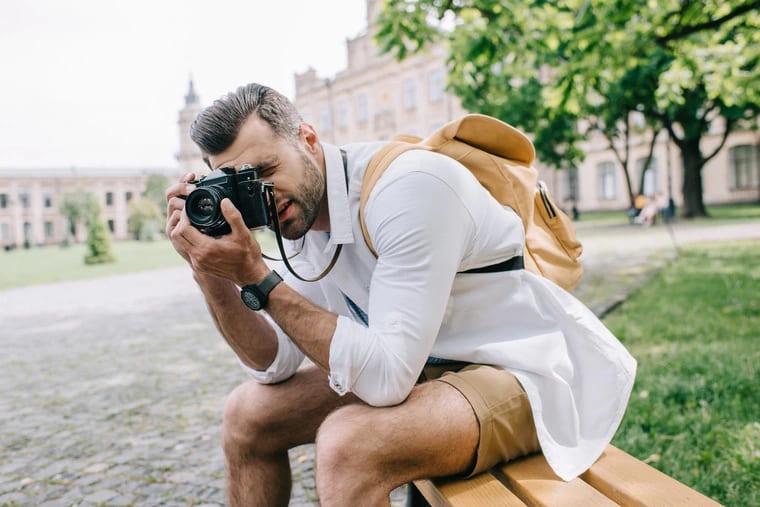When starting photography, everyone wants to make beautiful, memorable shots. Some people get it right away, some people get it with experience.
Some, being disappointed, give up the hobby without waiting for an acceptable result. In this article, Photography Art will share the secrets of various techniques that will make it easier for you to take cool photos.
Composition
In general, the composition is understood as the totality and mutual arrangement of objects in the picture. The construction of a composition or its vision in everyday life situations is an integral part of a photographer's work.

Unlike the technical subtleties of photography, mastering the skills of building a successful composition is much more difficult. However, there are a few theoretical aspects that every beginner photographer should know.
Linear perspective
Photography is a way of displaying the three-dimensional world on a two-dimensional plane, so the perception of the picture is somehow related to linear perspective.
It adds volume to the picture, destroys the wall between the photograph and the viewer. In order to maintain the correct perspective, the camera must be level with the subject, and the plane of focus must be parallel to it. Otherwise, unwanted perspective distortions and violations of proportions will appear in the photo.

Such a mistake is often encountered by novice photographers when working with people. When shooting high-rise buildings, it is often impossible to avoid this effect due to the too close location of the object.
The story center of photography
It is an object or some part of it that attracts attention. A correctly chosen plot center is the key to a "sticking" photo. Depending on the genre of photography, the focal point can be anything: the entire fence or graffiti on it, a model, the model's face or just the eyes.
Read also: Improving photos on a smartphone
A bright plot center attracts the attention of the viewer, and an unsuccessful one makes the picture uninteresting. In the example below, the photographer scattered the viewer's attention between two plot centers: children playing on the near and far rings.

The main task of the photographer is to find the plot center of the future photo and to separate everything superfluous from it with the help of compositional techniques.
The rule of thirds
One of the basic concepts of composition. Let's divide the frame into nine equal rectangles. The four points formed by the intersection of the lines attract the viewer's attention more strongly than other parts of the picture. Experienced photographers build the composition so that the main details are right here.
To simplify the task, almost all cameras and applications for smartphones have a function that allows you to display virtual lines on the screen or in the viewfinder while shooting.

It should be noted that the rule is not absolute. Do not waste effort on placing the object at the point of intersection of the segments. Quite a small distance from the center.
The rule of thirds is often supplemented by the rule of diagonals. This popular method of constructing a frame composition is based on the diagonal placement of objects in the picture.

Contrary to the rule of thirds, photographers use center framing. This is a method of constructing a composition, in which the object of the shooting is located symmetrically with respect to a horizontal or vertical line passing through the center of the frame.

Frame lighting. Types and basic techniques
Lighting is an equally important component of the picture. Bad lighting can ruin the best shot. Just as the best light cannot breathe life into a poorly composed photograph.
The importance of light can be inferred from the complexity of the schemes used by professionals during studio shooting. This is the subject of more detailed consideration. At this stage, we will get acquainted with the main types of lighting and light in the photo.
Read also: Gentleman's set for product photography
In the presence of a diffuser, the light is divided into:
- directional - the shadows are sharply defined, the chiaroscuro boundary is clear.
- diffuse - evenly illuminates the entire surface of the object.
- combined - a combination of the first and second type.
According to the number of directions, light is:
- simple (one source).
- complex (multiple sources).
By hardness:
- hard - source - gas discharge lamp or filament. With harsh lighting, the border of the shadows is precisely outlined, and the relief is hyperbolized.
- soft - there is a translucent screen between the source and the object. Soft lighting reduces the relief of the object.
According to the angle of incidence, the light is:
- straight (the angle of incidence is more than 45 degrees).
- oblique (less than 45 g).
- sliding (close to 0 g).
Division by type of lighting
Drawing light
Light directed at the subject. Its task is to create the volume and relief of the composition. The source can be both hard and soft. In studio conditions, it is placed at an average distance from the object. Not more than two meters.
With natural lighting, the role of such a source is played by the sun's rays passing through a window opening or a tree crown.
Fills the light
Such lighting gradually fills the composition of the frame. The light is diffused, soft. There is no chiaroscuro pattern. They are used for processing details together with other types of lighting.
Modeling light
It is used to select a certain area of the composition, obtain reflections, impressions, and soften shadows. It is formed by a small source that creates a narrow, directional light stream.
Light background
Background lighting helps to separate the model from the background, to show the depth of space. Usually, background light is less intense than fill or draw. It is extremely difficult to get such lighting in natural conditions.
Control light
As with background lighting, the light source is located behind the composition, but it is directed not at the background, but at the object of the shooting. As a result, a light edging of the contours of the object is obtained.
When working with light, remember that the change in illumination affects the highlights and shadows of the picture differently: the brightness of dark areas decreases more slowly than light areas. As a result, the decrease in illumination causes a drop in contrast. When placing lighting sources, it is worth paying attention to their distance from the shooting object. The closer the source is to the illuminated body, the sharper the boundaries of the shadows.
Shooting angle
Angle in photography refers to the location of the camera in relation to the object being photographed. The success of a good picture largely depends on the right angle.
Top angle (the camera is higher than the subject)
Often used to fit a frame more space. With this angle, official events (meetings, councils, meetings) are often filmed, in addition, the top angle is obtained when shooting from a quadcopter.

When photographing people, the upper angle is used when it is necessary to visually reduce the figure of the model. In this case, the emphasis will shift to availability.
Shooting at the level (the camera is at the same level as the shooting object)
It is used to obtain the most natural picture without breaking the proportions and shifting the emphasis to some part of the object.

Bottom angle (camera below the subject)
Using this position of the camera, you can visually enlarge the object in the frame, give it "weight" and significance. Using the angle in a portrait shot can have the unwanted effect of enlarging the lower part of the face.
Shooting from the ground (camera near the ground)
This angle makes you look at the world with different eyes. Perspective allows you to look at familiar objects from a completely different angle. From such an angle, interesting shots are obtained after rain, when the surface reflects light better.

Shooting from above (the camera is perpendicular to the plane on which the object is located)
With such a perspective, it ceases to affect the size of objects, which allows you to get an idea of their real sizes. Photos of this angle, taken by quadcopters, look impressive.

Having mastered the basic techniques of composition and understanding the construction of lighting, you and those around you will definitely notice the quality of the resulting pictures.



No comments yet